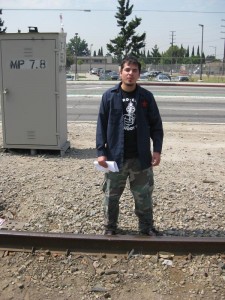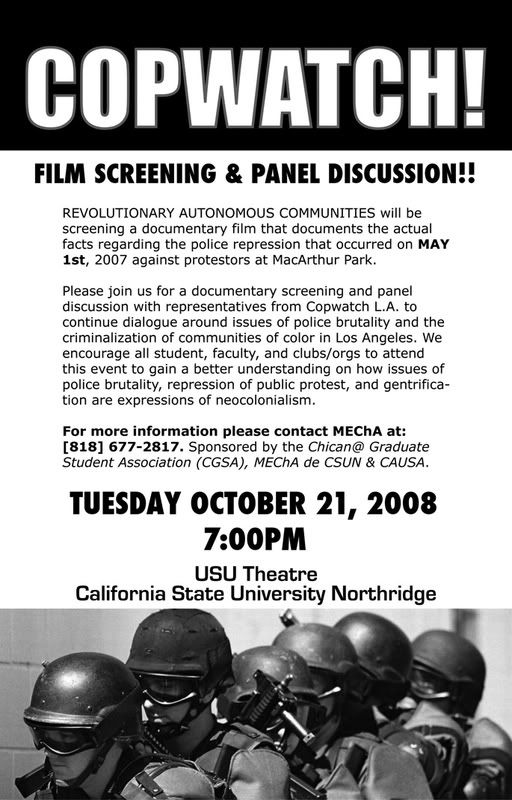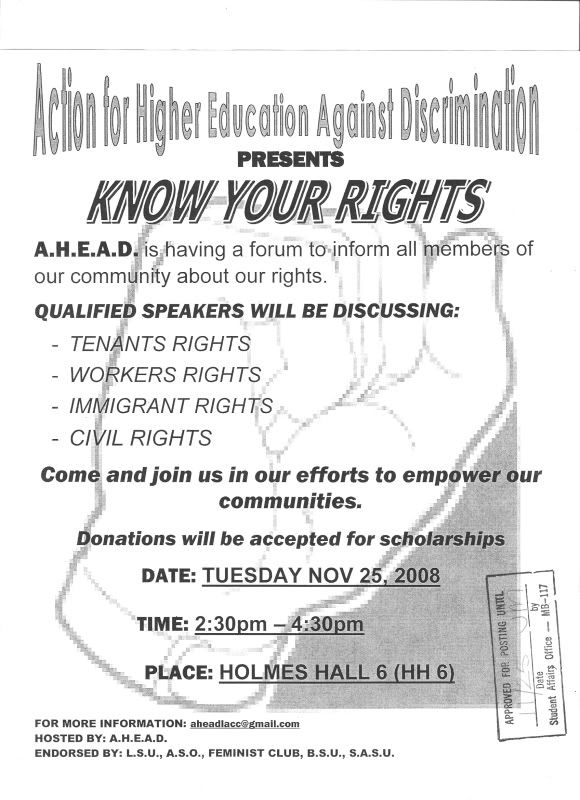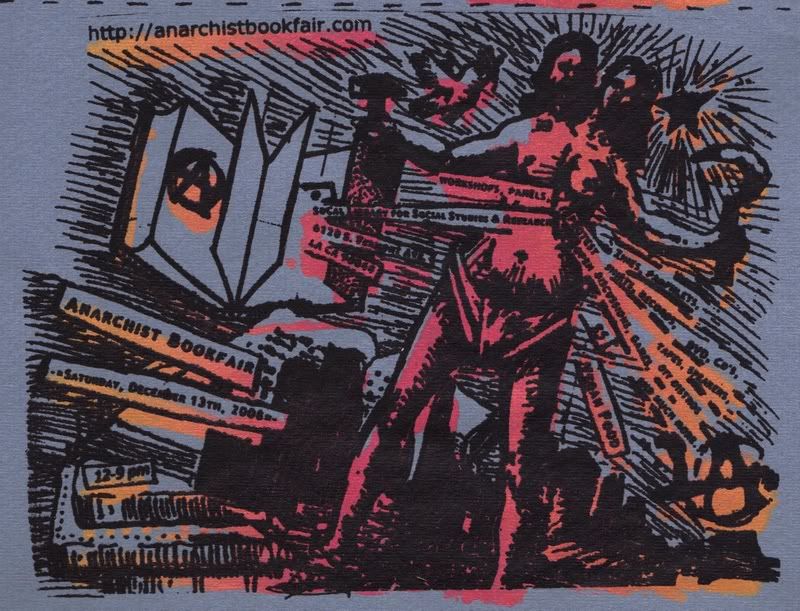Hi Everyone,
Please check out "The Empire Is Losing Its Grip: An Interview with
Joaquin Cienfuegos" at
http://www.revolutionbythebook.akpress.org/the-empire-is-losing-its-grip/
Thanks
Chuck Morse
The Empire Is Losing Its Grip: An Interview with Joaquin Cienfuegos
By Chuck Morse | October 29, 2008
Joaquin Cienfuegos, twenty-five, is a longtime anarchist militant, member of Revolutionary Autonomous Communities, Cop Watch Los Angeles, Anarchist People of Color (APOC), and one of the organizers of the first annual LA Anarchist Bookfair, which will occur on December 13, 2008. I spoke with Cienfuegos about his recent conflicts with law enforcement and his activism generally. ~ Chuck Morse
Communities, Cop Watch Los Angeles, Anarchist People of Color (APOC), and one of the organizers of the first annual LA Anarchist Bookfair, which will occur on December 13, 2008. I spoke with Cienfuegos about his recent conflicts with law enforcement and his activism generally. ~ Chuck Morse
* * *
Can you tell us about your arrest in July and where your case stands at the moment?
On June 27, the police pulled me over as I was giving a compañero a ride to his house. They looked through my trunk and found fliers for the Summer Solidarity Festival for the Black Rider 3 (three political prisoners held on trumped up conspiracy and weapons charges) and then pulled out a black case holding my legally owned AR-15. They immediately took me into custody and charged me with unlawful possession of an assault rifle.
This wasn’t the first time I’ve dealt with political repression or with police harassment. Growing up Chicano in the neo-colonies of Fresno and South Central, Los Angeles, this is business as usual. Of course, the state wants to have a monopoly on guns and violence and views everyone in our communities as criminals. That is why they relate to us in the way they do and don’t hesitate to kill innocent people in our neighborhoods.
I’m fighting my case. My next court date is November 6. Guillermo Suarez, a radical civil rights attorney, is representing me. And people in the movement generally, and anarchists around the world in particular, have supported me, my family, and my organization.
What can people do to support you?
Any support is appreciated. I was bailed out thanks to the help of the people, my friends and comrades, and we want to pay those folks back. We have a website up where people can contribute at www.diyzine.com/freejoaquin.
Also, the Revolutionary Autonomous Communities (RAC), along with Anarchist People of Color (APOC), is building a defense fund so we will be prepared when something like this happens again in the future. We know that this isn’t the first or last time that there will be political repression.
You’re active in a wide range of local activities. Please tell us about these.
I’ve been involved in Cop Watch LA for almost three years. We came out of the STOP Coalition (Stop Terrorism and Oppression by the Police), the Los Angeles Chapter of the Southern California Anarchist Federation (SCAF), the Raise the Fist Direct Action Network, and youth involved in defending the South Central Farm.
Cop Watch is a tactic and an arm of a larger, multi-faceted strategy and movement. It’s a way for people to begin resisting, taking direct action, combating state terrorism, and building autonomous and liberated communities. Specifically, every week an organized group of three to five people patrol the neighborhoods they live in with cameras. Each person has a role in the patrol (like note taker, first camera person, second camera person, police liaison, and community outreach person). We encourage people to check out our site, www.copwatchla.org.
I’m a member of the Guerrilla Chapter of Cop Watch LA, which is made up of individuals from different communities who have made a commitment to building a mass movement against police terrorism. This is one of the community programs of the Revolutionary Autonomous Communities. RAC was formed after SCAF-LA disbanded by the working-class youth of color that continue to collectively fight for a revolutionary organization, vision, and strategy. We’re a horizontalist federation of indigenous people (people of color) living in the neo-colonies, who believe that we need to create our own vision and go back to our roots, where we feel that anarchism and/or anarcho-communism lives already. So, we take a lot from anarchist, Zapatista, and Magonista principles, and at the same time we want to create something that is relevant to our own unique conditions and experiences.
RAC has also created a food program in McArthur Park, in Pico Union. Every Sunday for the past year, RAC and supporters have fed about 200 people. We get food donations, and people bag and distribute healthy fruits and vegetables. We get financial donations so each person can get a bag of beans every week. It has grown thanks to ideas from the people who have taken ownership of the program. Our goal is to connect it to the broader struggle for land and liberty.
RAC began the food program after the repression of the immigrant rights march on May Day 2007, to build a base of support and to build trust. We’re doing this in a community that police, after the 1992 Los Angeles rebellion, described in this way: “If this was an insurrection, Pico Union would be considered enemy territory.” It is a community that has been terrorized by Rampart police, but also one that comes with experience of rebellion and civil war in Central America and has a hatred for US imperialism. We feel that the food program and Cop Watch LA are just the beginning. We hope to spread these programs and support others who wish to do the same.
RAC also produced a film called, “We’re Still Here, We Never Left,” which exposes the police repression on Mayday, 2007. We really want people to see it. To get a copy or discuss screening the film, please write rac@riseup.net.
I’m also part of the collective organizing the first annual Los Angeles Anarchist Bookfair on December 13, 2008, which will help raise money for our defense fund and the South West Regional APOC gathering. For more information, visit, www.anarchistbookfair.com.
I’m part of APOC as well, which is growing and becoming a real network, and has the potential to grow into a revolutionary movement and become an intercommunalist force within the empire and beyond. Recently, there have been regional and local gatherings of Anarchists People of Color to build up to a inter-regional gathering. We have also discussed what APOC means and how it doesn’t just stand for Anarchist People of Color, but also Angry and Autonomous People of Color, and how all those things are unique and have their own definitions. (See www.illvox.org)
In your opinion, what are the greatest challenges facing the anarchist movement right now?
Many anarchists focus on solidarity work, which is a part of supporting revolution worldwide, but we have to move beyond solidarity and redefine what it means. Solidarity means that we fight alongside comrades and oppressed people everywhere, that we build the revolutionary process inside the empire, while sharing whatever resources we have with each other. In America, the anarchists have to begin to hold each other accountable and challenge each other’s privilege. We have to begin to break out of our sub-culture. We have to integrate into our communities and plant deep roots among the people as revolutionaries; to realize that our principles and ideas have to be popularized among the people, so they can take these up and make them their own. We have much more to learn than we have to teach, and not everyone will identify as an anarchist. Anarchists within the empire have to realize that there is so much privilege here, but also that there is what Huey Newton called the inner-third world—colonized people fighting within the empire—and their autonomy and self-determination should be supported.
Finally, if all your greatest dreams and hopes for the movement were to come true in, say, twenty years, what would the movement be? What would it be like?
I think there are two parts to this question: where would the people be in twenty years and where would the system of capitalism-imperialism, white supremacy, and patriarchy be by that time?
I can answer the second part quickly, because I don’t think that the system will last that long. The empire is losing its grip on the world and on the neo-colonies and people will free themselves of this horrible way of life. Of course nothing is certain, but we have to do the work.
My vision of liberated communes would be of people living their lives and realizing their full human  potential; where we live in harmony with the planet and all beings; where a federation of communes shares resources, food, ideas, and other things with each other; where people are rebuilding and healing from years of oppressive social relationships and their effects on us and the Earth; where technology is used to benefit not destroy people and the environment. In twenty years, borders would begin to come down, and rebellion will liberate peoples and their lands. I dream of this world everyday, where oppression because of the color of your skin, your class, your gender, your sexuality, and so on, are not tolerated and where people realize that they have the power to deal with all of these problems themselves. Maybe the world will not be like this in twenty years, but I know that we’ll be closer to it than we are now. That world is possible. That world is necessary.
potential; where we live in harmony with the planet and all beings; where a federation of communes shares resources, food, ideas, and other things with each other; where people are rebuilding and healing from years of oppressive social relationships and their effects on us and the Earth; where technology is used to benefit not destroy people and the environment. In twenty years, borders would begin to come down, and rebellion will liberate peoples and their lands. I dream of this world everyday, where oppression because of the color of your skin, your class, your gender, your sexuality, and so on, are not tolerated and where people realize that they have the power to deal with all of these problems themselves. Maybe the world will not be like this in twenty years, but I know that we’ll be closer to it than we are now. That world is possible. That world is necessary.





